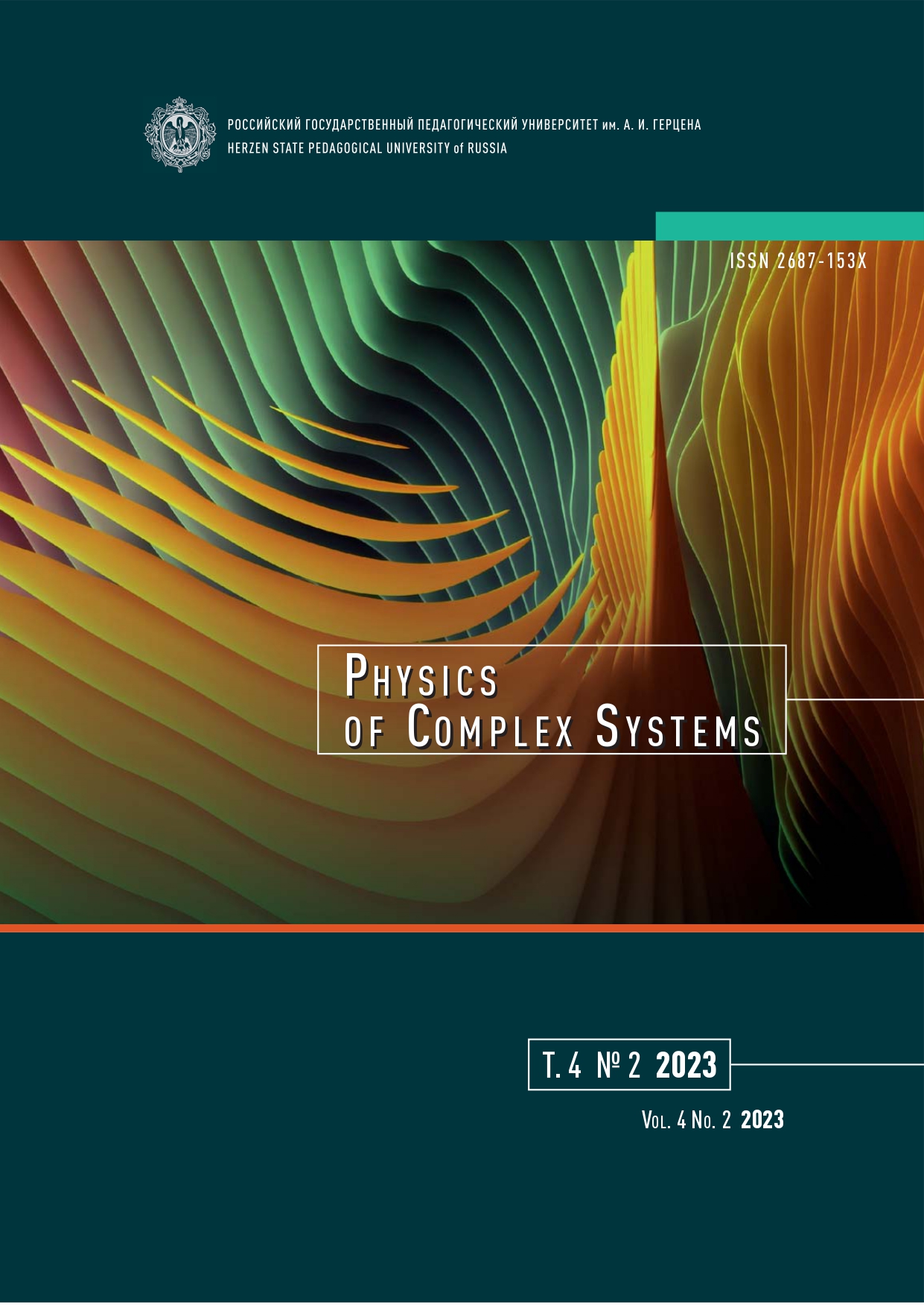О температуре волосатых черных дыр
DOI:
https://doi.org/10.33910/2687-153X-2023-4-2-59-67Ключевые слова:
волосатая черная дыра, температура Хокинга, заряженная черная дыра, гравитационное расщепление, уравнения ЭйнштейнаАннотация
Метод гравитационного расщепления представляет собой чрезвычайно полезный инструмент для получения новых решений уравнений Эйнштейна посредством минимальных геометрических деформаций. В данной работе мы рассматриваем волосатые заряженные черные дыры, полученные гравитационным расщеплением, и вычисляем их температуру Хокинга, чтобы сравнить ее со случаем, когда волосы не учитываются. Мы выяснили, что волосы при некоторых условиях параметров черной дыры влияют на температуру Хокинга и могут ее повышать. Мы также выяснили, что температура черной дыры в волосатом случае не зависит от электрического заряда.
Библиографические ссылки
Banados, M., Silk, J., West, S. M. (2009) Kerr black holes as particle accelerators to arbitrarily high energy. Physical Review Letters, 103 (11), article 111102. https://doi.org/10.1103/PhysRevLett.103.111102 (In English)
Brown, J. D., Creighton, J., Mann, R. B. (1994) Temperature, energy, and heat capacity of asymptotically anti–de Sitter black holes. Physical Review D, 50 (10), article 6394. https://doi.org/10.1103/PhysRevD.50.6394 (In English)
Carlip, S. (2009) Black hole thermodynamics and statistical mechanics. Lecture Notes in Physics, 769, 89–123. https://doi.org/10.1007/978-3-540-88460-6_3 (In English)
Cavalcanti, R. T., Alves, K. D. S., Hoff da Silva, J. M. (2022). Near-horizon thermodynamics of hairy black holes from gravitational decoupling. Universe, 8 (7), article 363. https://doi.org/10.3390/universe8070363 (In English)
Contreras, E., Ovalle, J., Casadio, R. (2021) Gravitational decoupling for axially symmetric systems and rotating black holes. Physical Review D, 103 (4), article 044020. https://doi.org/10.1103/PhysRevD.103.044020 (In English)
Gibbons, G. W., Hawking, S. W. (1977) Action integrals and partition functions in quantum gravity. Physical Review D, 15 (10), article 2752. https://doi.org/10.1103/PhysRevD.15.2752 (In English)
Grib, A. A., Pavlov, Yu. V. (2015) Are black holes totally black? Gravitation and Cosmology, 21 (1), 13–18. https://doi.org/10.1134/S0202289315010065 (In English)
Grib, A. A., Pavlov, Yu. V. (2022) On phase transitions near black holes. JETP Letters, 116 (8), 493–499. https://doi.org/10.1134/S0021364022601907 (In English)
Hawking, S. W. (1975) Particle creation by black holes. Communications in Mathematical Physics, 43 (3), 199–220. https://doi.org/10.1007/BF02345020 (In English)
Hawking, S. W., Perry, M. J., Strominger, A. (2016) Soft hair on black holes. Physical Review Letters, 116 (23), article 231301. https://doi.org/10.1103/PhysRevLett.116.231301 (In English)
Mahapatra, S., Banerjee, I. (2023) Rotating hairy black holes and thermodynamics from gravitational decoupling. Physics of the Dark Universe, 39, article 101172. https://doi.org/10.1016/j.dark.2023.101172 (In English)
Ovalle, J. (2017) Decoupling gravitational sources in general relativity: From perfect to anisotropic fluids. Physical Review D, 95 (10), article 104019. https://doi.org/10.1103/PhysRevD.95.104019 (In English)
Ovalle, J., Casadio, R., Contreras, E., Sotomayor, A. (2021) Hairy black holes by gravitational decoupling. Physics of the Dark Universe, 31, article 100744. https://doi.org/10.1016/j.dark.2020.100744 (In English)
Ovalle, J., Casadio, R., da Rocha, R. et al. (2018) Black holes by gravitational decoupling. The European Physical Journal C, 78, article 960. https://doi.org/10.1140/epjc/s10052-018-6450-4 (In English)
Poisson, E. (2007) A relativist’s toolkit: The mathematics of black-hole mechanics. Cammbridge: Cambridge University Publ., 233 p. (In English)
Ramos, A., Arias, C., Avalos, R., Contreras, E. (2021) Geodesic motion around hairy black holes. Annals of Physics, 431, article 168557. https://doi.org/10.1016/j.aop.2021.168557 (In English)
Vagnozzi, S., Rittick, R., Yu-Dai, T. et al. (2022) Horizon-scale tests of gravity theories and fundamental physics from the Event Horizon Telescope image of Sagittarius A*. arXiv, article 2205.07787. [Online]. Available at: https://doi.org/10.48550/arXiv.2205.07787 (accessed 10.03.2023). (In English)
Vertogradov, V. (2022). On the particle collisions during gravitational collapse of Vaidya spacetimes. arXiv:2211.16189. [Online]. Available at: https://doi.org/10.48550/arXiv.2211.16189 (accessed 17.01.2023). (In English)
Vertogradov, V., Misyura, M. (2022) Vaidya and generalized vaidya solutions by gravitational decoupling. Universe, 8 (11), article 567. https://doi.org/10.3390/universe8110567 (In English)
Visser, M. (1992) Dirty black holes: Thermodynamics and horizon structure. Physical Review D, 46 (6), article 2445. https://doi.org/10.1103/PhysRevD.46.2445 (In English)
Zaslavskii, O. B. (2012) Acceleration of particles by black holes as a result of deceleration: Ultimate manifestation of kinematic nature of BSW effect. Physics Letters B, 712 (3), 161–164. https://doi.org/10.1016/j.physletb.2012.05.009 (In English)
Загрузки
Опубликован
Выпуск
Раздел
Лицензия
Copyright (c) 2023 Вертоградов Виталий Дмитриевич, Кудрявцев Дмитрий Александрович

Это произведение доступно по лицензии Creative Commons «Attribution-NonCommercial» («Атрибуция — Некоммерческое использование») 4.0 Всемирная.
Авторы предоставляют материалы на условиях публичной оферты и лицензии CC BY 4.0. Эта лицензия позволяет неограниченному кругу лиц копировать и распространять материал на любом носителе и в любом формате в любых целях, делать ремиксы, видоизменять, и создавать новое, опираясь на этот материал в любых целях, включая коммерческие.
Данная лицензия сохраняет за автором права на статью, но разрешает другим свободно распространять, использовать и адаптировать работу при обязательном условии указания авторства. Пользователи должны предоставить корректную ссылку на оригинальную публикацию в нашем журнале, указать имена авторов и отметить факт внесения изменений (если таковые были).
Авторские права сохраняются за авторами. Лицензия CC BY 4.0 не передает права третьим лицам, а лишь предоставляет пользователям заранее данное разрешение на использование при соблюдении условия атрибуции. Любое использование будет происходить на условиях этой лицензии. Право на номер журнала как составное произведение принадлежит издателю.







